Abstract
Violence and drugs seem to mix readily. In this paper, relevant correlational studies are briefly reviewed and methodological issues are discussed. With a focus on alcohol, facts pointing to some type of causal relationship are presented both from crime and laboratory manipulative studies. Dose and rate-dependent anxiolytic, psychomotor stimulant and alteration in inhibitory and problem-solving cognitive functions are each in turn seen as precipatory to aggression. Drugs other than alcohol which interact with these systems are also discussed.
Full text
PDF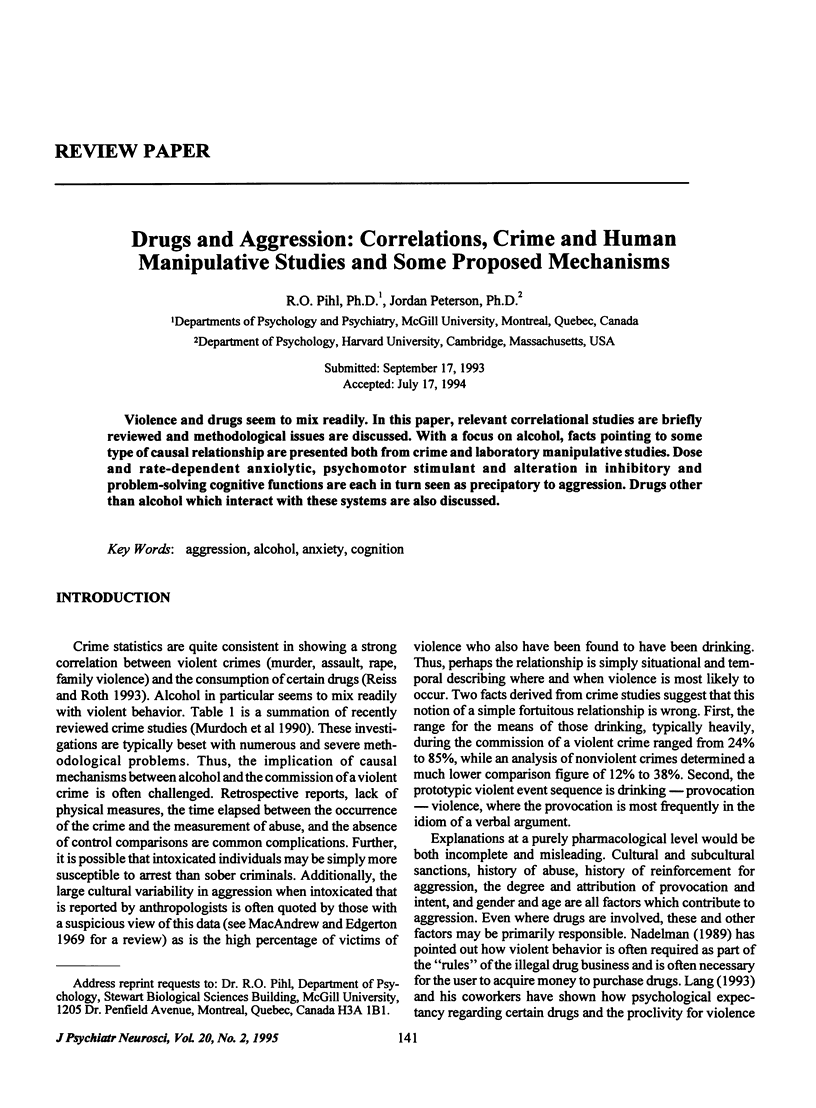
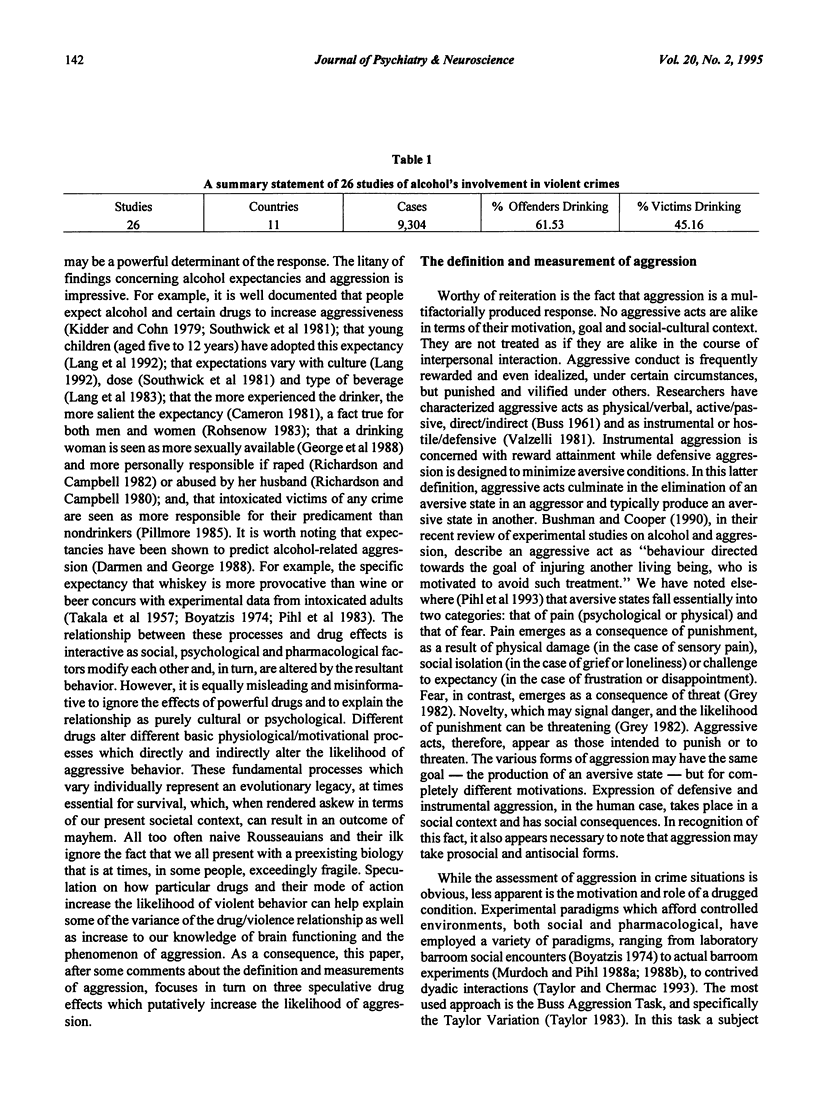
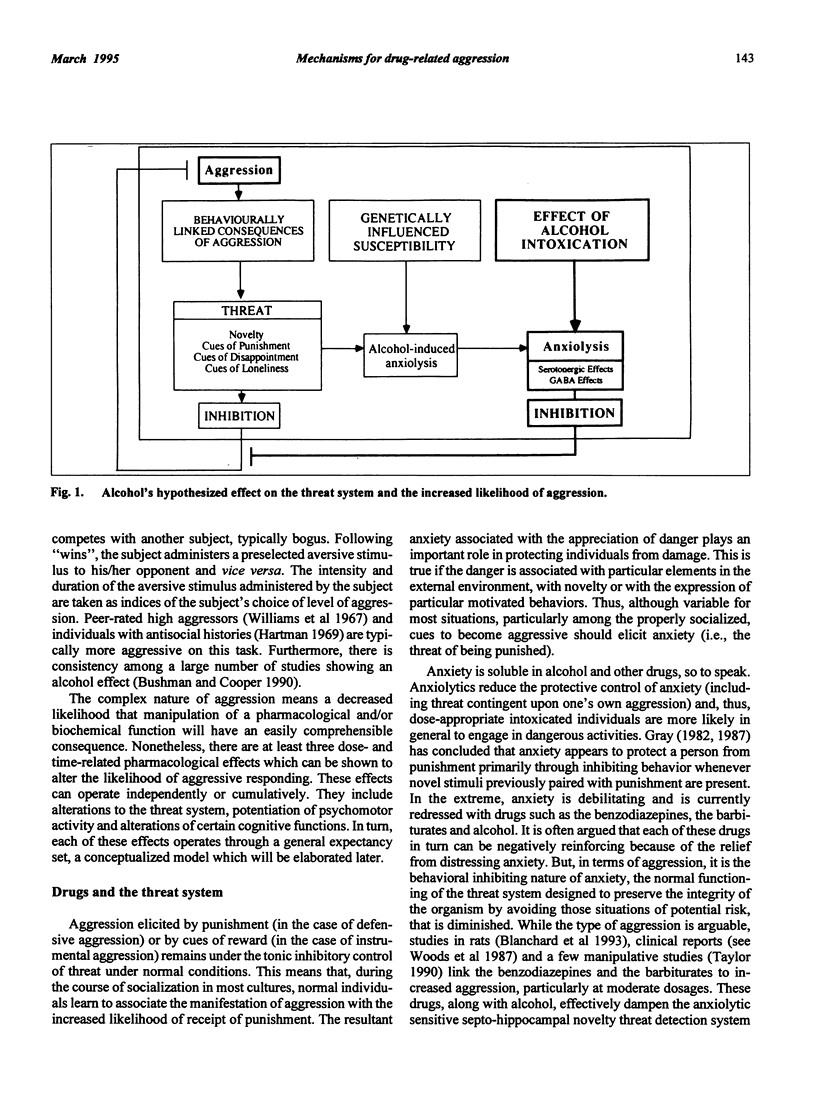
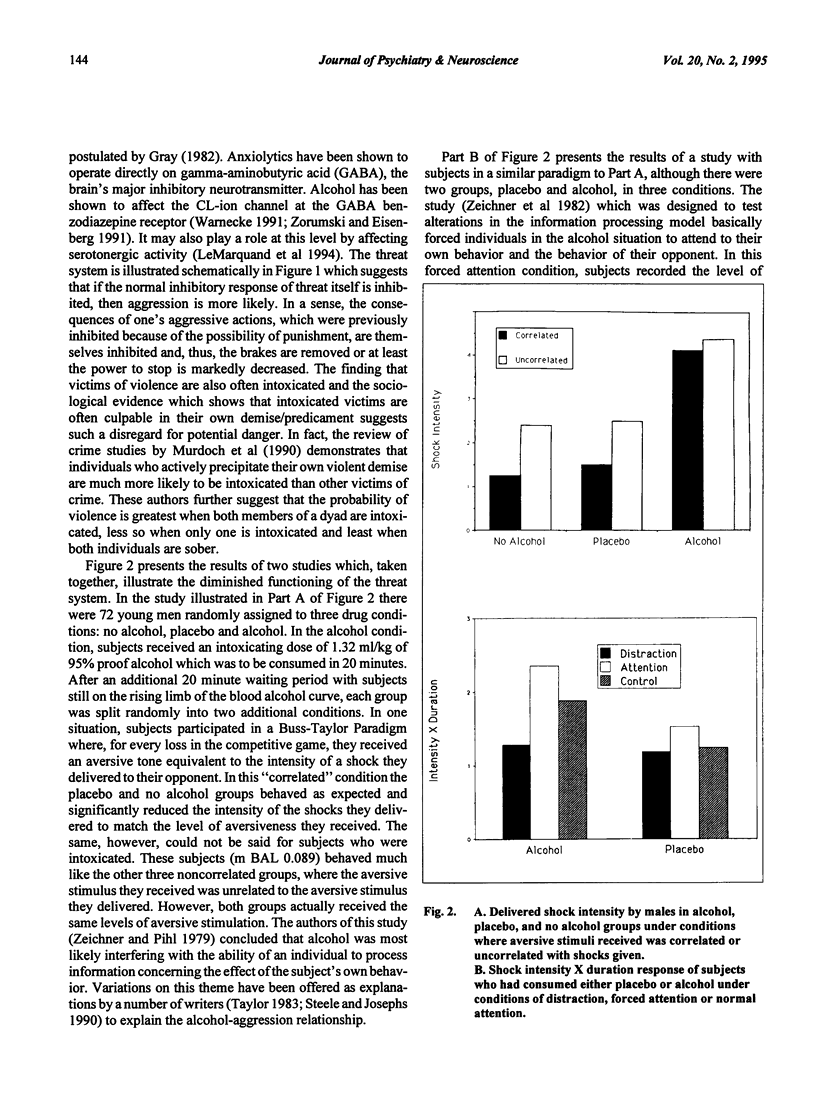
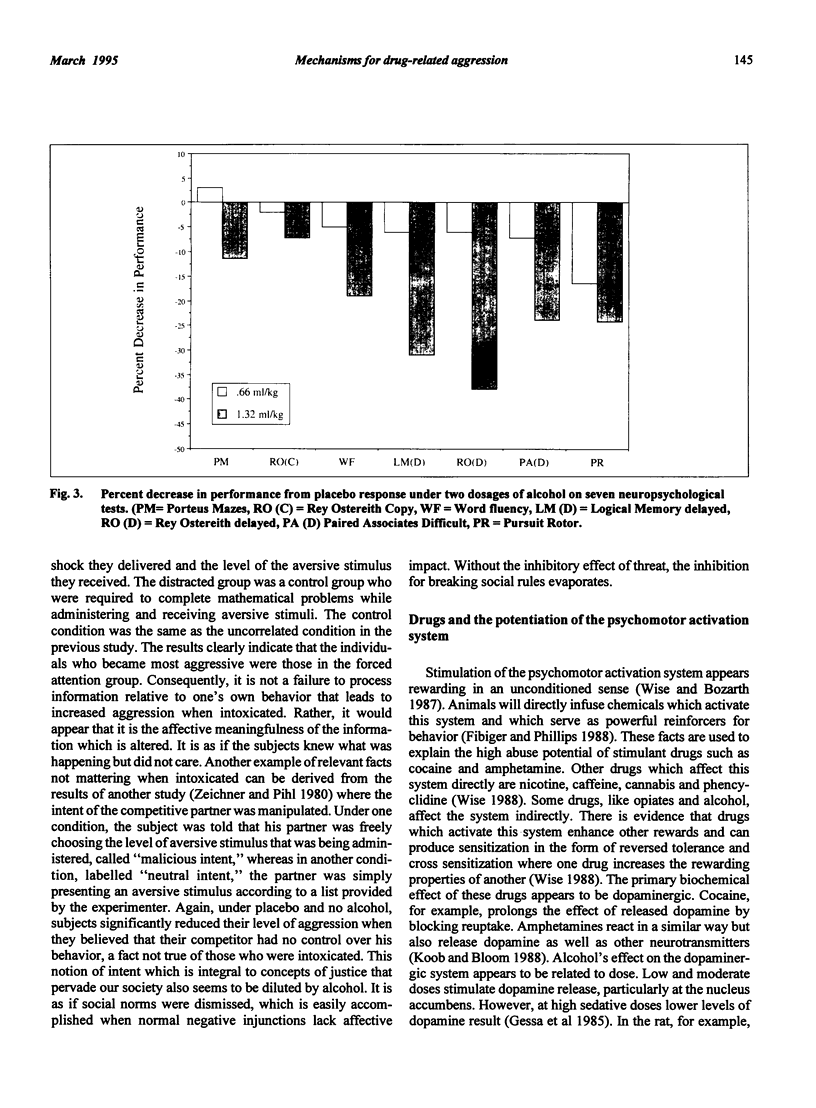
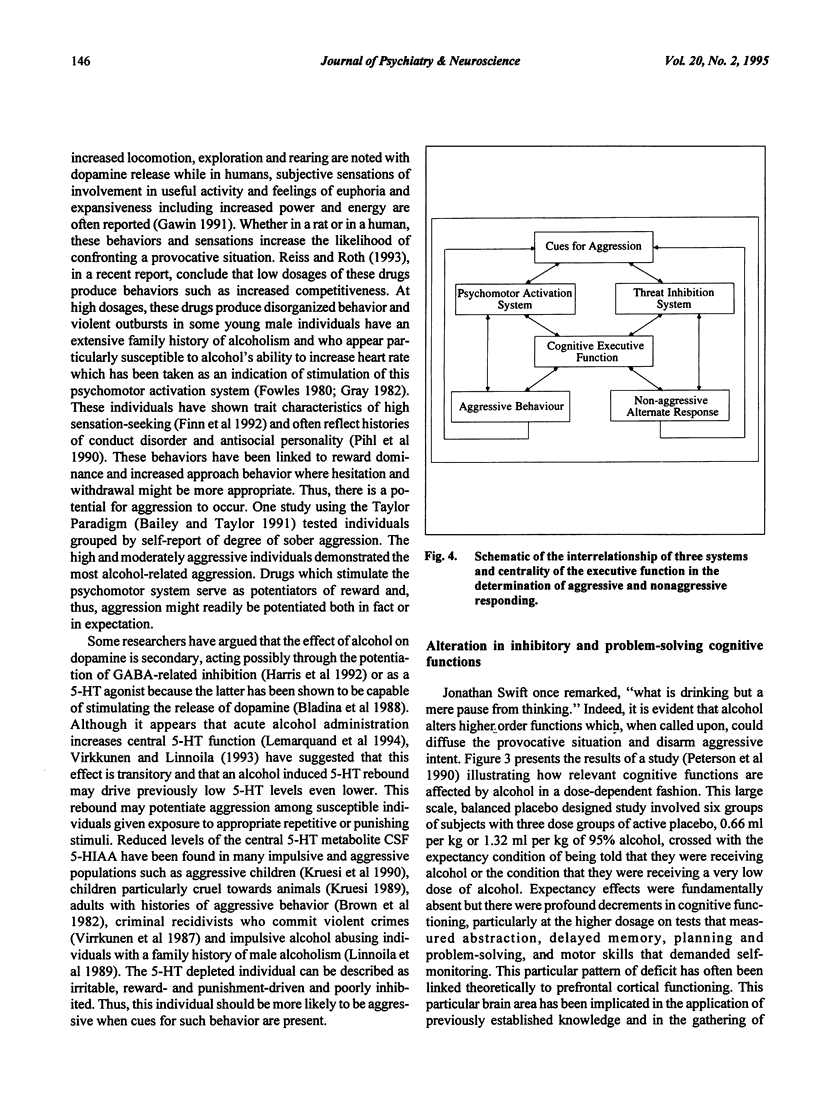
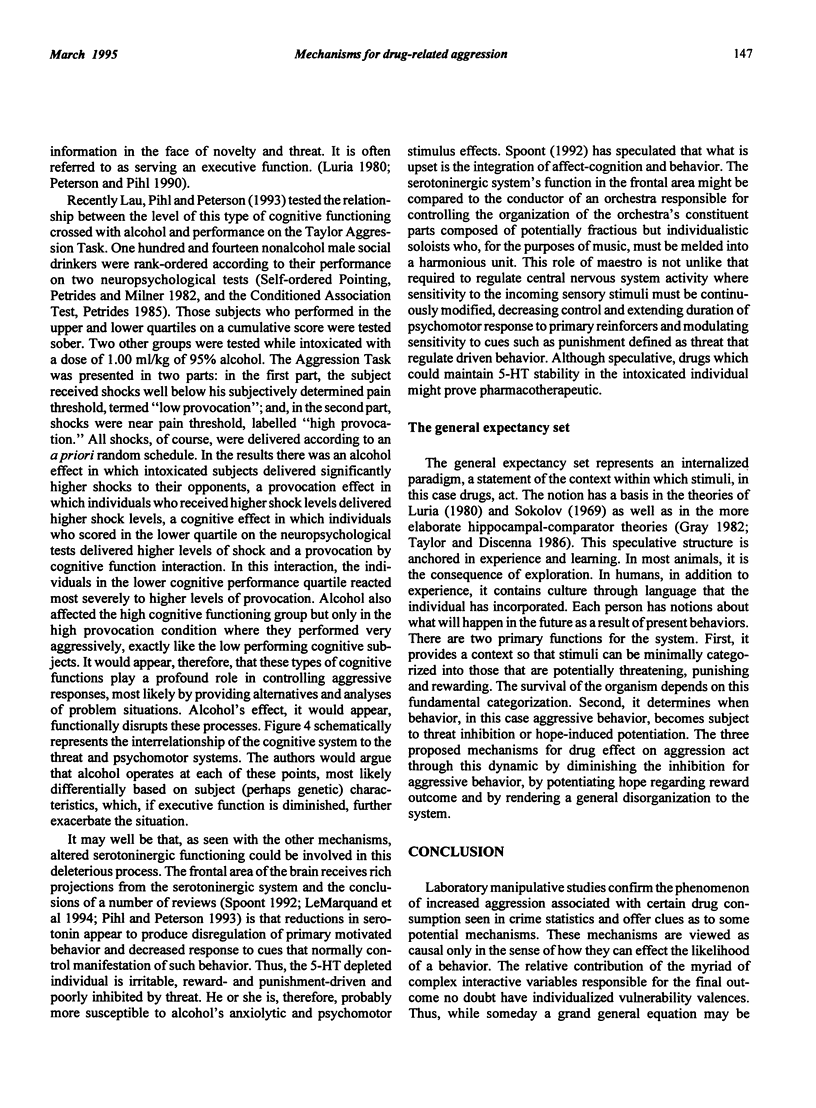
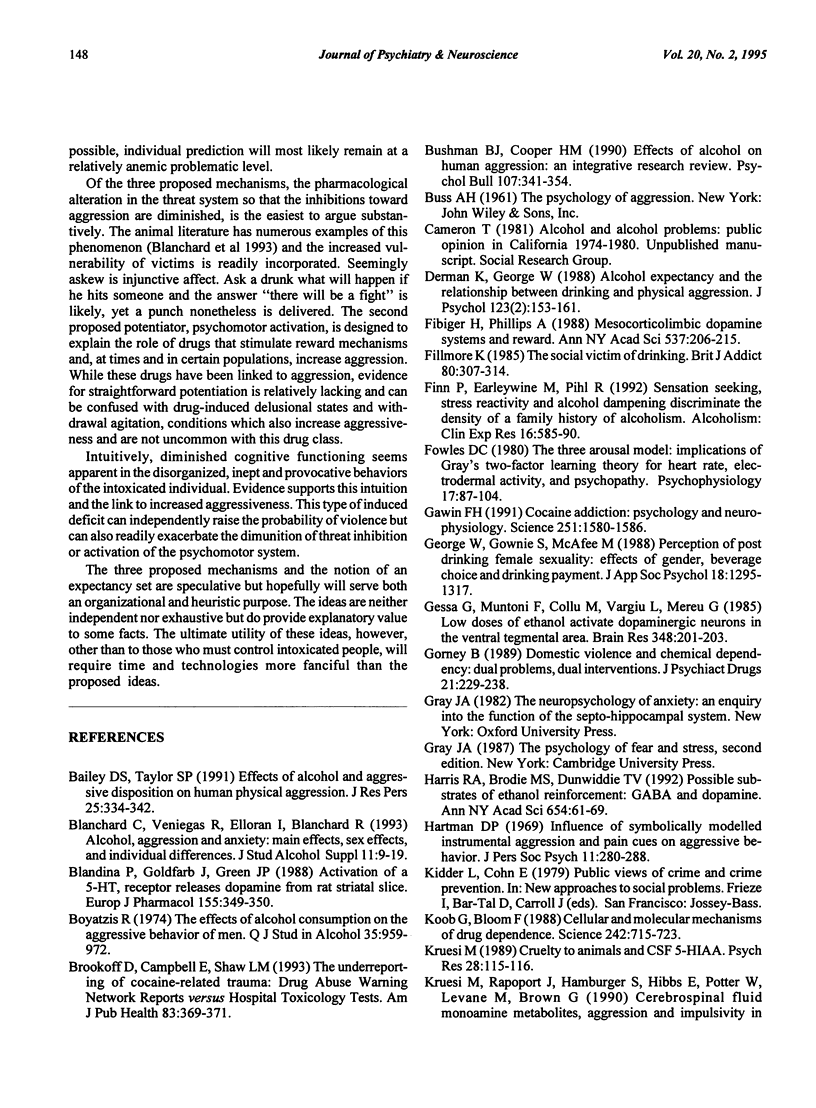

Images in this article
Selected References
These references are in PubMed. This may not be the complete list of references from this article.
- Blanchard D. C., Veniegas R., Elloran I., Blanchard R. J. Alcohol and anxiety: effects on offensive and defensive aggression. J Stud Alcohol Suppl. 1993 Sep;11:9–19. doi: 10.15288/jsas.1993.s11.9. [DOI] [PubMed] [Google Scholar]
- Blandina P., Goldfarb J., Green J. P. Activation of a 5-HT3 receptor releases dopamine from rat striatal slice. Eur J Pharmacol. 1988 Oct 18;155(3):349–350. doi: 10.1016/0014-2999(88)90528-6. [DOI] [PubMed] [Google Scholar]
- Boyatzis R. E. The effect of alcohol consumption on the aggressive behavior of men. Q J Stud Alcohol. 1974 Sep;35(3):959–972. [PubMed] [Google Scholar]
- Brookoff D., Campbell E. A., Shaw L. M. The underreporting of cocaine-related trauma: drug abuse warning network reports vs hospital toxicology tests. Am J Public Health. 1993 Mar;83(3):369–371. doi: 10.2105/ajph.83.3.369. [DOI] [PMC free article] [PubMed] [Google Scholar]
- Bushman B. J., Cooper H. M. Effects of alcohol on human aggression: an integrative research review. Psychol Bull. 1990 May;107(3):341–354. doi: 10.1037/0033-2909.107.3.341. [DOI] [PubMed] [Google Scholar]
- Dermen K. H., George W. H. Alcohol expectancy and the relationship between drinking and physical aggression. J Psychol. 1989 Mar;123(2):153–161. doi: 10.1080/00223980.1989.10542971. [DOI] [PubMed] [Google Scholar]
- Fibiger H. C., Phillips A. G. Mesocorticolimbic dopamine systems and reward. Ann N Y Acad Sci. 1988;537:206–215. doi: 10.1111/j.1749-6632.1988.tb42107.x. [DOI] [PubMed] [Google Scholar]
- Fillmore K. M. The social victims of drinking. Br J Addict. 1985 Sep;80(3):307–314. doi: 10.1111/j.1360-0443.1985.tb02544.x. [DOI] [PubMed] [Google Scholar]
- Finn P. R., Earleywine M., Pihl R. O. Sensation seeking, stress reactivity, and alcohol dampening discriminate the density of a family history of alcoholism. Alcohol Clin Exp Res. 1992 Jun;16(3):585–590. doi: 10.1111/j.1530-0277.1992.tb01421.x. [DOI] [PubMed] [Google Scholar]
- Fowles D. C. The three arousal model: implications of gray's two-factor learning theory for heart rate, electrodermal activity, and psychopathy. Psychophysiology. 1980 Mar;17(2):87–104. doi: 10.1111/j.1469-8986.1980.tb00117.x. [DOI] [PubMed] [Google Scholar]
- Gawin F. H. Cocaine addiction: psychology and neurophysiology. Science. 1991 Mar 29;251(5001):1580–1586. doi: 10.1126/science.2011738. [DOI] [PubMed] [Google Scholar]
- Gessa G. L., Muntoni F., Collu M., Vargiu L., Mereu G. Low doses of ethanol activate dopaminergic neurons in the ventral tegmental area. Brain Res. 1985 Nov 25;348(1):201–203. doi: 10.1016/0006-8993(85)90381-6. [DOI] [PubMed] [Google Scholar]
- Gorney B. Domestic violence and chemical dependency: dual problems, dual interventions. J Psychoactive Drugs. 1989 Apr-Jun;21(2):229–238. doi: 10.1080/02791072.1989.10472163. [DOI] [PubMed] [Google Scholar]
- Harris R. A., Brodie M. S., Dunwiddie T. V. Possible substrates of ethanol reinforcement: GABA and dopamine. Ann N Y Acad Sci. 1992 Jun 28;654:61–69. doi: 10.1111/j.1749-6632.1992.tb25956.x. [DOI] [PubMed] [Google Scholar]
- Hartmann D. P. Influence of symbolically modeled instrumental aggression and pain cues on aggressive behavior. J Pers Soc Psychol. 1969 Mar;11(3):280–288. doi: 10.1037/h0027071. [DOI] [PubMed] [Google Scholar]
- Koob G. F., Bloom F. E. Cellular and molecular mechanisms of drug dependence. Science. 1988 Nov 4;242(4879):715–723. doi: 10.1126/science.2903550. [DOI] [PubMed] [Google Scholar]
- Kruesi M. J. Cruelty to animals and CSF 5HIAA. Psychiatry Res. 1989 Apr;28(1):115–116. doi: 10.1016/0165-1781(89)90203-5. [DOI] [PubMed] [Google Scholar]
- Kruesi M. J., Rapoport J. L., Hamburger S., Hibbs E., Potter W. Z., Lenane M., Brown G. L. Cerebrospinal fluid monoamine metabolites, aggression, and impulsivity in disruptive behavior disorders of children and adolescents. Arch Gen Psychiatry. 1990 May;47(5):419–426. doi: 10.1001/archpsyc.1990.01810170019003. [DOI] [PubMed] [Google Scholar]
- LeMarquand D., Pihl R. O., Benkelfat C. Serotonin and alcohol intake, abuse, and dependence: clinical evidence. Biol Psychiatry. 1994 Sep 1;36(5):326–337. doi: 10.1016/0006-3223(94)90630-0. [DOI] [PubMed] [Google Scholar]
- Linnoila M., DeJong J., Virkkunen M. Monoamines, glucose metabolism, and impulse control. Psychopharmacol Bull. 1989;25(3):404–406. [PubMed] [Google Scholar]
- Murdoch D. D., Pihl R. O., Ross D. The influence of dose, beverage type, and sex of interactor on female bar patrons' verbal aggression. Int J Addict. 1988 Sep;23(9):953–966. doi: 10.3109/10826088809058851. [DOI] [PubMed] [Google Scholar]
- Murdoch D., Pihl R. O., Ross D. Alcohol and crimes of violence: present issues. Int J Addict. 1990 Sep;25(9):1065–1081. doi: 10.3109/10826089009058873. [DOI] [PubMed] [Google Scholar]
- Peterson J. B., Rothfleisch J., Zelazo P. D., Pihl R. O. Acute alcohol intoxication and cognitive functioning. J Stud Alcohol. 1990 Mar;51(2):114–122. doi: 10.15288/jsa.1990.51.114. [DOI] [PubMed] [Google Scholar]
- Petrides M. Deficits on conditional associative-learning tasks after frontal- and temporal-lobe lesions in man. Neuropsychologia. 1985;23(5):601–614. doi: 10.1016/0028-3932(85)90062-4. [DOI] [PubMed] [Google Scholar]
- Petrides M., Milner B. Deficits on subject-ordered tasks after frontal- and temporal-lobe lesions in man. Neuropsychologia. 1982;20(3):249–262. doi: 10.1016/0028-3932(82)90100-2. [DOI] [PubMed] [Google Scholar]
- Pihl R. O., Smith M., Farrell B. Alcohol and aggression in men: a comparison of brewed and distilled beverages. J Stud Alcohol. 1984 May;45(3):278–282. doi: 10.15288/jsa.1984.45.278. [DOI] [PubMed] [Google Scholar]
- Rohsenow D. J. Drinking habits and expectancies about alcohol's effects for self versus others. J Consult Clin Psychol. 1983 Oct;51(5):752–756. doi: 10.1037//0022-006x.51.5.752. [DOI] [PubMed] [Google Scholar]
- Southwick L., Steele C., Marlatt A., Lindell M. Alcohol-related expectancies: defined by phase of intoxication and drinking experience. J Consult Clin Psychol. 1981 Oct;49(5):713–721. doi: 10.1037//0022-006x.49.5.713. [DOI] [PubMed] [Google Scholar]
- Steele C. M., Josephs R. A. Alcohol myopia. Its prized and dangerous effects. Am Psychol. 1990 Aug;45(8):921–933. doi: 10.1037//0003-066x.45.8.921. [DOI] [PubMed] [Google Scholar]
- Taylor S. P., Chermack S. T. Alcohol, drugs and human physical aggression. J Stud Alcohol Suppl. 1993 Sep;11:78–88. doi: 10.15288/jsas.1993.s11.78. [DOI] [PubMed] [Google Scholar]
- Teyler T. J., DiScenna P. The hippocampal memory indexing theory. Behav Neurosci. 1986 Apr;100(2):147–154. doi: 10.1037//0735-7044.100.2.147. [DOI] [PubMed] [Google Scholar]
- Virkkunen M., Linnoila M. Brain serotonin, type II alcoholism and impulsive violence. J Stud Alcohol Suppl. 1993 Sep;11:163–169. doi: 10.15288/jsas.1993.s11.163. [DOI] [PubMed] [Google Scholar]
- Virkkunen M., Nuutila A., Goodwin F. K., Linnoila M. Cerebrospinal fluid monoamine metabolite levels in male arsonists. Arch Gen Psychiatry. 1987 Mar;44(3):241–247. doi: 10.1001/archpsyc.1987.01800150053007. [DOI] [PubMed] [Google Scholar]
- Warneke L. B. Benzodiazepines: abuse and new use. Can J Psychiatry. 1991 Apr;36(3):194–205. doi: 10.1177/070674379103600308. [DOI] [PubMed] [Google Scholar]
- Wise R. A., Bozarth M. A. A psychomotor stimulant theory of addiction. Psychol Rev. 1987 Oct;94(4):469–492. [PubMed] [Google Scholar]
- Wise R. A. Psychomotor stimulant properties of addictive drugs. Ann N Y Acad Sci. 1988;537:228–234. doi: 10.1111/j.1749-6632.1988.tb42109.x. [DOI] [PubMed] [Google Scholar]
- Woods J. H., Katz J. L., Winger G. Abuse liability of benzodiazepines. Pharmacol Rev. 1987 Dec;39(4):251–413. [PubMed] [Google Scholar]
- Zeichner A., Pihl R. O. Effects of alcohol and behavior contingencies on human aggression. J Abnorm Psychol. 1979 Apr;88(2):153–160. doi: 10.1037//0021-843x.88.2.153. [DOI] [PubMed] [Google Scholar]
- Zeichner A., Pihl R. O. Effects of alcohol and instigator intent on human aggression. J Stud Alcohol. 1980 Mar;41(3):265–276. doi: 10.15288/jsa.1980.41.265. [DOI] [PubMed] [Google Scholar]
- Zeichner A., Pihl R. O., Niaura R., Zacchia C. Attentional processes in alcohol-mediated aggression. J Stud Alcohol. 1982 Jul;43(7):714–724. doi: 10.15288/jsa.1982.43.714. [DOI] [PubMed] [Google Scholar]
- Zorumski C. F., Isenberg K. E. Insights into the structure and function of GABA-benzodiazepine receptors: ion channels and psychiatry. Am J Psychiatry. 1991 Feb;148(2):162–173. doi: 10.1176/ajp.148.2.162. [DOI] [PubMed] [Google Scholar]



